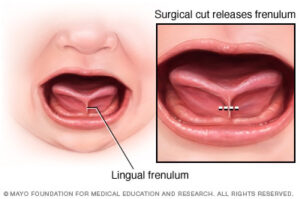Tongue-tie is a common condition, present at birth. Tongue-tie (Ankyloglossia ) can cause difficulty with breastfeeding, speech, digestion and breathing. Fortunately, Tongue-tie is easy to correct.
What Is Tongue-Tie?
Before birth, the lingual frenulum, the tissue between the bottom of the tongue’s tip and the floor of the mouth, separates. Ankyloglssia, commonly known as Tongue-tie, occurs when an unusually short lingual frenulum remains attached and restricts the movement of the tongue. The cause is unknown but may be associated with genetic factors and is more common in boys.

Source: WebMD
The Effects of Tongue-Tie
Normal tongue movement is important for good nutrition, dental health and communication. Limited tongue motion caused by Tongue-tie can present challenges at every age.
Breast-feeding:
At birth, Tongue-tie can cause breast-feeding difficulties. A baby with Tongue-tie has a hard time keeping his or her tongue in the right spot to get breast milk. This can cause inadequate nutrition for the baby and breast pain for the mother.
Speech development:
Tongue-tie can interfere with the ability to make certain sounds such as “t,” “d,” “z,” “s,” “th,” “r” and “l.”
Dental health:
Tongue-tie limits the motion of the tongue, making it difficult to use the tongue to clean food debris from teeth while eating. Tongue-tie can also contribute to the formation of a gap between the bottom front teeth, which can affect chewing and dental hygiene. Tongue-tie can also lead to jaw pain and sleep disordered breathing.
Oral activities:
Tongue tie can affect the ability to eat certain foods like ice cream cones and lollipops. Older patients with Tongue-tie may have difficulty with dental hygiene and keeping dentures in place.
How to Treat Tongue-Tie
Tongue-tie is corrected by releasing the frenum under the tongue for better range of motion. This procedure is called frenectomy, and can be achieved by cutting the frenum with a scalpel or painlessly vaporizing with a laser.
Laser Frenectomy
In most cases, Dr. Geetha Srinivasan of the Collegeville Trappe Gentle Dentist recommends laser frenectomy. This quick, in-office Tongue-tie treatment is generally pain-free and takes only a few minutes. For this simple treatment, Dr. Srinivasan uses a soft tissue laser. The laser sterilizes the area, reducing the risk of infection. There is very little discomfort and almost no bleeding from the laser treatment. This is a very safe in-office procedure and doesn’t require stitches or general anesthesia.
Tongue-Tie Symptoms
If you notice any of these common symptoms of tongue-tie in your child or yourself, make an appointment to see your dentist for diagnosis and treatment.
- Difficulty with moving the tongue from side to side or up to the top teeth.
- Difficulty with sticking out the tongue.
- Limited tongue movement that affects eating, speaking or reaching the back teeth.
- A tongue that looks notched or heart shaped when stuck out.
- Challenges with breast feeding and latching on.
- Difficulty making certain sounds or other speech development issues.
- Indications of airway obstruction related sleep disturbances including habitual snoring, trouble breathing at night, and daytime symptoms like sleepiness or trouble with attention or behavior.
Please contact our office for more information about tongue-tie diagnosis and treatment as well as laser dentistry services.

